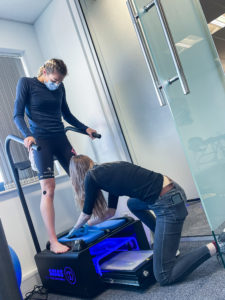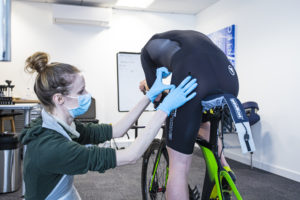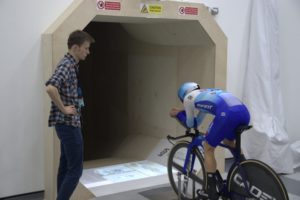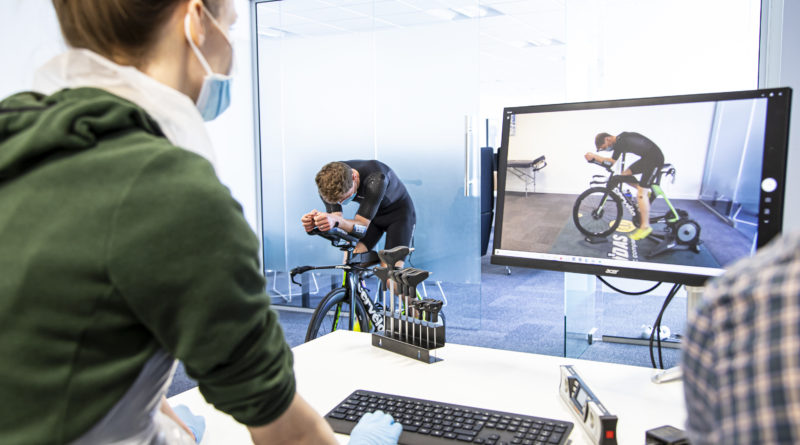Fitter’s Corner; bike fit and your bike shop
In part 2 of this series with professional bike fitters we chat with Bianca Broadbent, learn why ongoing professional development underpins any successful business…
How did you get started as a bike fitter?
In 2009 I graduated from University, and, in typical fashion, got a job nearly 150 miles away. At this point I couldn’t drive, and local public transport where I’d moved to was not great. Though the thought of cycling 10-15 miles seemed really far at this point (how funny things are when you look back) I decided to purchase a decent road bike for local travel.
When I started using the bike I couldn’t get completely comfortable, and I just thought “there’s gotta be ways to make the bike better.”
For many new cyclists it’s still commonplace to just buy a bike and walk out of the shop with it. If you’re new to cycling one of the biggest bike buying challenges is the knowledge gap – how do we ask questions about things we don’t know about?
That, informally, is how my journey as a Bike Fitter started; I did some research, and started fettling with the bike, did more reading, and started to experiment with my position and the set up of the bike…
With 9 years of bike fitting experience I still consider myself relatively new to the profession. Despite having a degree in Physiotherapy – so a deep understanding of anatomy, physiology, and human movement (biomechanics) – at the start of my bike fitting journey I didn’t see a clearly defined path, so I found it really interesting and enabling to follow the careers of those who had a good head start.
Simply put, my career as a Bike Fitter evolved from solving my own bike fit challenges to fettling with other people’s bikes. Granted the Physiotherapy knowledge aided this, although I’d point out that at times it’s not as straightforward a transfer of knowledge as might be casually considered.
As Jon Wild stated in a previous Cycling Industry New feature, if bike fitting is what you want to do, you can’t just wait for a job to be advertised. When jobs are advertised all to often they are poorly paid for the level of knowledge and investment required to become a great Bike Fitter, and don’t offer support and structure in the workplace. In short, you really need to carve your own path.
How long does it take / what does it cost to become a solver of complex bike fit problems?
 I think the answer to this really comes back to what your background is and how much exposure you have had to complex scenarios. Nothing can replace volume, seeing, and doing – I’m sure this is universal across many professions. For example, as a Physiotherapist, I’ve already had extensive experience with complex injuries, rehabilitation, and essentially human engineering. However some of my peers who may have come from an engineering background may have a broader knowledge of the bike, and what strategies may work better in other scenarios e.g. splitter systems and the like.
I think the answer to this really comes back to what your background is and how much exposure you have had to complex scenarios. Nothing can replace volume, seeing, and doing – I’m sure this is universal across many professions. For example, as a Physiotherapist, I’ve already had extensive experience with complex injuries, rehabilitation, and essentially human engineering. However some of my peers who may have come from an engineering background may have a broader knowledge of the bike, and what strategies may work better in other scenarios e.g. splitter systems and the like.
As someone with a Physiotherapy background I would just like to point out that in no way do I profess to have all the bike fitting answers.
I firmly believe that bike fitting should very much be an inter-disciplinary profession – we should draw on the experience of our peers and also know when something needs additional input or expertise.
There are wide-reaching instances of this such as when a client might present following an injury and they need a period of rehabilitation before their position can be optimised, or when something really is beyond the remit of a bike fit.
What’s the biggest change you’ve seen in bike fitting?
I think the biggest change I have seen is probably that of a cultural one. Before, bike fitting seemed like this magical dark art, and what you as a fitter might see on a routine basis, might be a completely new phenomenon to the client. I think nowadays there is much more awareness from the client on what they can change and indeed they seem better informed about what options might be available to them. I think people are perhaps also more open to change now – certainly with the evolution of aerodynamics – there’s a real drive to want to be as competitive as you can be.
What’s the biggest myth about bike fitting?
I’d say the biggest myth I think that exists is that you need a saddle based on your ischial tuberosity width.
It’s not as simple as that, because some people will load the ischial ramus rather than the “sit bones”. I suspect some of this comes back to the fact that most people refer to the ischial rami and ischial tuberosities (very different parts of the bony structure of the pelvis) interchangeably i.e. bony loading. If you are in an aggressive position on the bike, and your pelvis is rotated anteriorly (forward), then you are understandably going to load a different part of the bony structure of your pelvis.
 A practical example of this: People frequently purchase TT saddles based on ischial tuberosity width but if you look at the width of an ISM saddle for example, you will see it generally has a wider nose vs rear to accommodate this change in loading pattern.
A practical example of this: People frequently purchase TT saddles based on ischial tuberosity width but if you look at the width of an ISM saddle for example, you will see it generally has a wider nose vs rear to accommodate this change in loading pattern.
As in any professional environment I should say that this is not always the case. Generalisations must not be made. Each person is different. Averaged data can cause as many problems as it solves (proving that ‘average’ really isn’t ‘normal’).
Whilst there will be those who disagree with me on the subject of ischial tuberosity width and the way this is applied in bike fitting, the critical point is that each person being fitted will be different. How they ride, why they ride, where they ride, all need to be considered, along with a number of other factors ranging from the simple to complex.
Assessing the person in front of us enables us to deliver solutions for the individual. Universally applying preformatted ideas to every person we fit, without consideration for the individual sat in front of us, is where things can get troublesome.
How can customers tell which fitters are deeply knowledgeable, not just 2 day trained on a piece of technology?
One of the better ways for clients to research potential bike fitters is via the IBFI. The IBFI acts as a regulator of sorts, it aspires to standardise the industry by assigning fitters by competency and experience. That’s a good starting point.
It’s also important not to devalue the individual that has done just the 2-day course. We all have to start somewhere and, those new to the profession may bring experience that some of us just do not have, as well as a fresh pair of eyes.
Not everyone needs a super-duper in-depth bike fit to get them going, and actually, in some cases, this may deter those clients who need to get the ball rolling somewhere.
If in doubt, it would be sensible for a client to contact a bike fit practitioner for further information in advance of booking, or go through word of mouth.
Do you see repeat customers /are people loyal to a bike fitter?
Absolutely. However, the process of booking and receiving a bike fit isn’t like going to Costa Coffee every week, it’s a high-value item so for the client, it might be once a year, once every 5 years or, it may come through recommendations to family and friends. I also think a really important aspect of each bike fit is to try to empower the client to be self-efficacious, giving them the knowledge and the autonomy to problem solve minor issues and know when an appropriate time to seek help is.
What’s the furthest distance you’ve had a customer travel?
 Probably around 6000 miles, although that’s a technicality as they came for the full Vorteq capabilities – event specific, wind tunnel validated, Aero optimization, delivered with apparel and component partners, aligned with human performance consultancy – not me as an individual! (We have a contract with Team Bike Exchange to deliver a human performance strategy)
Probably around 6000 miles, although that’s a technicality as they came for the full Vorteq capabilities – event specific, wind tunnel validated, Aero optimization, delivered with apparel and component partners, aligned with human performance consultancy – not me as an individual! (We have a contract with Team Bike Exchange to deliver a human performance strategy)
Again, this just promotes the benefits of the inter-disciplinary team, because something which sells outcomes is going to be more appealing than just a standalone product.
Vorteq – based within Silverstone Sports Engineering Hub – are best described as a performance engineering business, with myself and colleague Dr Jamie Pringle specializing in the ‘Human Performance’ part of that package of integrated services.
As a team, we set up Matteo Sobrero and Simon Yates who won both TT stages at the 2022 Giro!
Do retail stores understand the commercial opportunity that comes with a truly skilled bike fitter?
Short answer: No.
I can can see how it might appear “risky” for a business to allocate a high area of floor space to something that they don’t necessarily understand, or perhaps don’t have the skills to utilise to it’s full potential.
For bike shops, a Bike Fit studio should function just as the workshop does – as a business unit within the store. If the business commits to hiring and supporting an enthusiastic, self motivated and professional fitter, then this person can develop a consistent additional revenue stream for the business.
Taking this approach directly addresses the “what to do if an employee leaves?” question. Attract talent with your business structures. This is very similar to hiring for workshop skills – it’s about mindset, outlook, environment, and capabilities.
Going back to something I said earlier, I think this is a real opportunity for those who want to get involved in bike fitting, that is, look to seek out and work with your local bike shop (this is how I got started anyway, and it seems others did too).
How does a business hire and get the best value out of an experienced bike fitter?
Well, I think this can be a tricky one. To give some signposts and direction:
The IBFI will support and provide mentorship to members, so that’s definitely a good place to start.
It’s also worth exploring the possibility to link up with a local fitter who may be operating independently, or even one who is interested in travelling to do a satellite clinic. That way space in-store can flexed according to the needs of each stakeholder, and does not need to be permanently allocated. It also offers the business an opportunity to see how bike fitting works in-store (both as cash value to business and relationship building value for both customer and business).
Having said that, there may be current members of staff who would express an interest in developing skills in this area. You don’t have to come from a medical background to be a fitter; sure it helps with anatomy, but there are so many amazing fitters out there who have just taken the time to educate themselves, apply what they’ve learned, practice, and become the capable individual they are today.
For those wanting to experience Bianca’s bike fitting skills first hand, or having customers who would benefit from her knowledge and experience, you can book via:
- Vorteq Sports
- Fit Your Bike (At the University of Birmingham)




